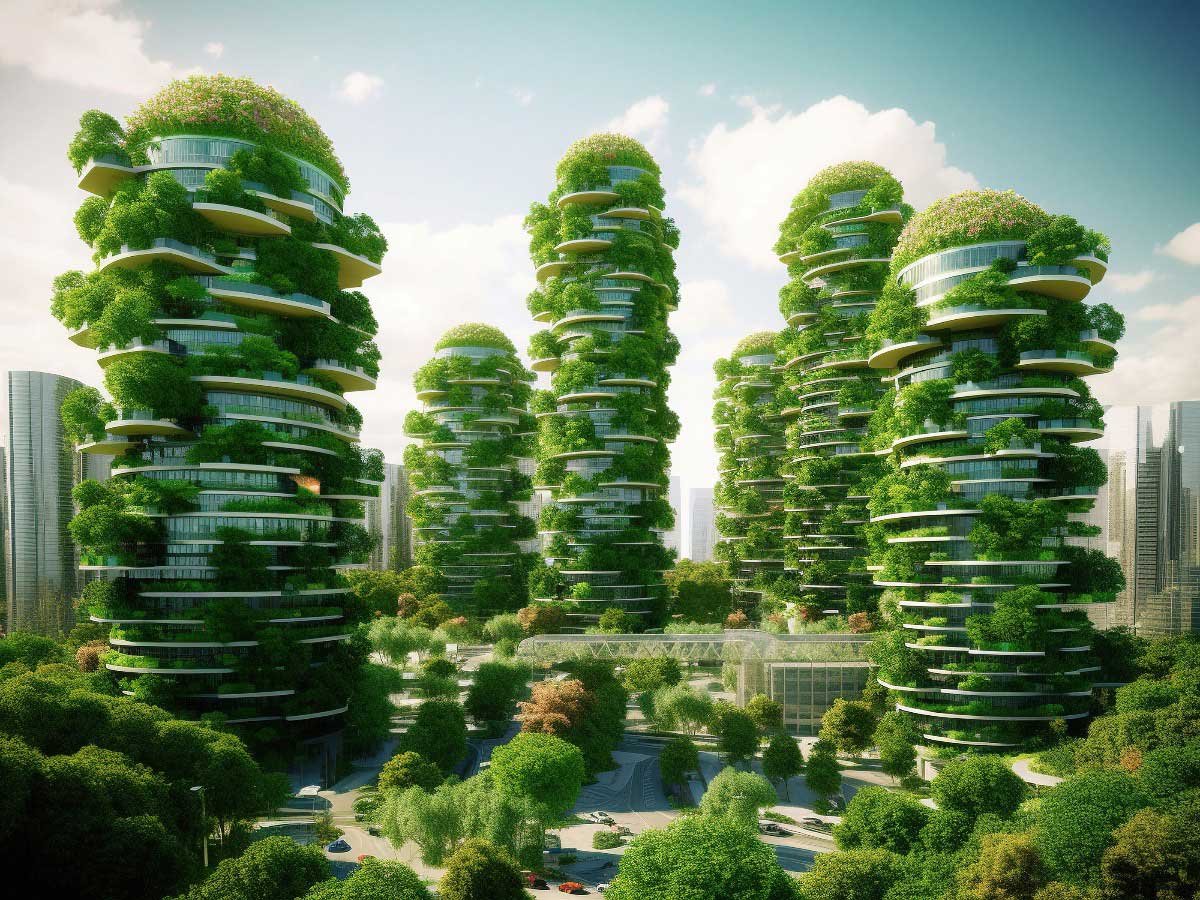The Incredible Benefits of Trees
14th July 2023
When we think about the wonders of nature, it's impossible to overlook the crucial role that trees play in sustaining and enriching our environment. Trees are not just beautiful to behold; they are the lifeline of our planet, providing numerous benefits that are essential for the health and wellbeing of all living organisms. From providing us with clean air to reducing noise pollution, trees offer a wide range of incredible benefits. In this article, we will explore the many ways in which trees enhance our lives and the environment around us. So, if you're ready to explore the remarkable importance of trees and why they deserve our utmost respect and protection, let’s dive into the fascinating world of arboriculture where you will find out some of the countless benefits that trees bring to our lives and learn how we can protect and preserve these invaluable resources for future generations.
Oxygen Production
First and foremost, trees are renowned for their unparalleled ability to convert carbon dioxide into oxygen through photosynthesis. Trees are often referred to as “the lungs of the Earth", absorbing carbon dioxide and releasing oxygen into the atmosphere. In fact, it is estimated that a large mature tree can produce enough oxygen for at least four people per year. As the global population continues to rise, the need for this oxygen-generating capacity becomes increasingly crucial.
Carbon Sinks
Trees not only provide us with the oxygen we need to breathe but also help to mitigate the impact of greenhouse gases. As our world grapples with increasing carbon emissions and the threat of climate change, trees act as natural carbon sinks, helping to counterbalance these detrimental effects. Trees absorb and store carbon dioxide during photosynthesis, converting it into biomass. Through this ability to sequester carbon dioxide, trees combat the rising levels of greenhouse gases in the atmosphere. Forest restoration and forest and woodland creation initiatives are therefore important to counterbalancing carbon emissions and preserving vital ecosystems. By protecting existing forests and promoting reforestation efforts, we can leverage the power of trees to help regulate temperature, conserve water, and mitigate both global and local climate change impacts.
Reducing Air Pollution
Trees also act as natural air filters, trapping airborne pollutants such as dust, smoke, and harmful gases. Their leaves absorb these pollutants and release clean oxygen, contributing to improved air quality. Studies have shown that urban areas with a higher density of trees experience reduced respiratory problems and lower levels of air pollution-related illnesses. The presence of trees in urban environments is especially crucial in combating the detrimental effects of vehicular emissions and industrial activities.
Local Climate Regulation
In addition to their oxygen-producing abilities, trees also play a crucial role in regulating local climate conditions. By absorbing solar radiation, providing shade and reducing the air temperature through evapotranspiration, trees help to cool the surrounding environment and combat the urban heat island effect. This is particularly beneficial in cities where concrete and tarmac surfaces absorb and radiate heat, leading to higher temperatures. As a result, trees help to create a more comfortable urban environment, reducing the need for excessive air conditioning and lowering energy consumption.
Global Climate Regulation
On a larger scale, forests also contribute to the regulation of global temperatures, again partly through the process of evapotranspiration. Trees release water vapor into the atmosphere through their leaves, which regulates humidity levels and cools the air to form clouds. These clouds then reflect solar radiation back into space, reducing the amount of heat absorbed by the Earth's surface. The moisture released by forests also helps maintain local and regional precipitation patterns, contributing to rain and snowfall and regulating water cycles.
Utilising Trees and Wood as a Renewable Energy Source
Wood is an exceptional renewable energy source with numerous benefits and has historically been the most widely used renewable energy source. Firstly, the trees from which wood is derived can be easily replenished through responsible forest management and planting initiatives. This makes wood a renewable resource that can be harvested and regrown over time. Furthermore, wood is carbon neutral when used for energy production. When burned, it releases carbon dioxide, but this is offset by the carbon dioxide absorbed by growing trees, creating a balanced carbon cycle. Additionally, wood can be used in various forms such as logs, pellets, or chips, making it versatile and adaptable for different energy needs. It is also widely available in many regions, reducing dependency on fossil fuels and promoting local energy production reducing road miles in the distribution. Furthermore, wood can be easily stored and transported, providing reliable energy even in remote areas.
The use of wood as a renewable energy source promotes local economies and job creation, particularly in forestry and wood processing industries, and can contribute to reducing greenhouse gas emissions and combating climate change. With these advantages, wood emerges as a sustainable choice that can play a crucial role in transitioning towards a cleaner and greener energy future.
Soil Conservation
Trees have a remarkable ability to reduce soil erosion and prevent water pollution. Their extensive root systems help to stabilise the soil, reducing the risk of landslides and the loss of fertile topsoil, preventing it from being washed away by rainwater or blown away by wind. In this way they not only protect the integrity of the land but also ensure that water sources remain clean and free from sediment and pollutants, as trees act as natural buffers, filtering and trapping pollutants before they reach streams, rivers, and groundwater sources. Forests in particular are vital for watershed protection, ensuring a sustainable supply of clean water for both human and animal populations.
Additionally, tree canopies intercept rainfall, reducing the impact of heavy downpours and preventing soil compaction. The roots of trees absorb excess water, preventing flooding, while also allowing for better groundwater recharge. In this way, by maintaining soil health and regulating water flow, trees protect both human settlements and natural habitats.
Biodiversity Hotspots
Trees provide essential habitats for a diverse range of wildlife, from birds and insects to mammals and reptiles. Forest ecosystems are incredibly rich in biodiversity, and trees serve as the foundation of these intricate ecosystems. They provide food, shelter, and nesting sites for countless species, playing a vital role in maintaining ecological balance.
The presence of trees in urban areas can also have a significant impact on wildlife. Even small urban green spaces with trees can attract a wide variety of bird species, butterflies, and other pollinators. By creating green corridors and connecting fragmented habitats, trees promote the movement of wildlife and support the survival of many species in urban environments.
Biodiversity is not only essential for the health of ecosystems but also for the wellbeing of humans. Interacting with nature and witnessing the diversity of plant and animal life can provide us with a sense of awe and inspiration. Moreover, studies have shown that spending time in green spaces can improve mental health, reduce stress, and enhance overall wellbeing (see below).
Forests, in particular, are biodiversity hotspots, supporting an astonishing diversity of flora and fauna. When we lose forests and trees, we not only disrupt entire ecosystems but also risk the extinction of numerous species. Protecting and restoring forests is crucial for preserving biodiversity and maintaining the delicate balance of nature.
The Psychological and Emotional Benefits of Trees on Human Health and Wellbeing
The benefits of trees extend beyond their physical impact on the environment. Green spaces, including parks and urban forests, provide places for relaxation, exercise, and social interaction. Research has shown that spending time in nature, particularly in the presence of trees, has a positive effect on our mental health and wellbeing. Research has shown that spending time in nature, especially when surrounded by trees, can reduce stress, improve mental health, and boost overall happiness. Spending time amongst trees has also been found to enhance cognitive functioning, improve attention span and has been linked to increased creativity and problem-solving abilities. In this way trees and the tranquillity of nature can provide a much-needed break from the fast-paced and stressful nature of modern life, allowing us to recharge and rejuvenate. Furthermore, as discussed earlier, trees in urban areas help to mitigate air pollution, absorbing harmful gases and particulate matter, thereby enhancing the quality of the air we breathe and promoting better physical health and wellbeing too.
Trees as Natural Sound Barriers
In addition to their visual appeal, trees also have the ability to reduce noise pollution. Dense tree canopies can act as natural sound barriers, absorbing and deflecting sound waves, thereby reducing the impact of noise from traffic, construction, and other urban activities. This can create a more peaceful and serene environment, further reducing stress, promoting better sleep and enhancing overall wellbeing.
The Economic Benefits of Trees
Beyond their environmental and psychological benefits, trees also have significant economic value. Urban forests and green spaces contribute to property values, making neighbourhoods more attractive and desirable. Studies have shown that homes surrounded by trees and well-maintained green spaces tend to sell at higher prices and sell more quickly.
As discussed earlier, trees provide shade, reducing the need for air conditioning and lowering energy costs. In urban areas, strategically placed trees can help to reduce the heat island effect, resulting in lower cooling costs for buildings and reducing the strain on the energy infrastructure.
Additionally, trees play a vital role in the timber and paper industries, providing raw materials for construction, furniture, and various wood-based products. This creates jobs and economic opportunities for communities that rely on forestry and related industries.
How to Plant and Care for Trees in Your Community
Now that we understand the incredible benefits that trees bring to our environment and wellbeing, it's essential to take action to protect and preserve them. One way to contribute is by planting trees in your community. Whether it's in your garden, local park, or along streets, every tree counts.
When planting trees, it is better to select native species that are well-suited to the local climate and soil conditions. Native trees that have adapted to your region's specific environmental conditions are much more likely to thrive. Proper planting techniques, including digging a wide planting hole and backfilling with compost or organic matter, can help trees establish strong root systems and ensure their long-term survival.
Caring for trees involves regular watering, mulching, and pruning. Watering is particularly important during the tree's establishment phase. Mulching helps to retain moisture, suppress weed growth, and regulate soil temperature. Pruning should be done to remove dead or damaged branches and to shape the tree for optimal growth and aesthetics.
Final Thoughts
The invaluable contributions of trees to the environment cannot be overstated. From providing us with life-sustaining oxygen to supporting biodiversity, protecting soil, improving air quality, and combating climate change, trees are the guardians of our planet. It is therefore important that we recognise and value their role in maintaining the delicate ecological balance. Conservation efforts, forestry initiatives, and sustainable practices are all necessary to ensure the preservation of existing forests and the cultivation of new ones. Together, let us celebrate the magnificence of trees and work to protect and restore the precious green spaces that are vital for the wellbeing of our planet and future generations.
If you have enjoyed this article and would like to support what we do by donating £2 or more to buy saplings to plant, please follow the link below:






























































